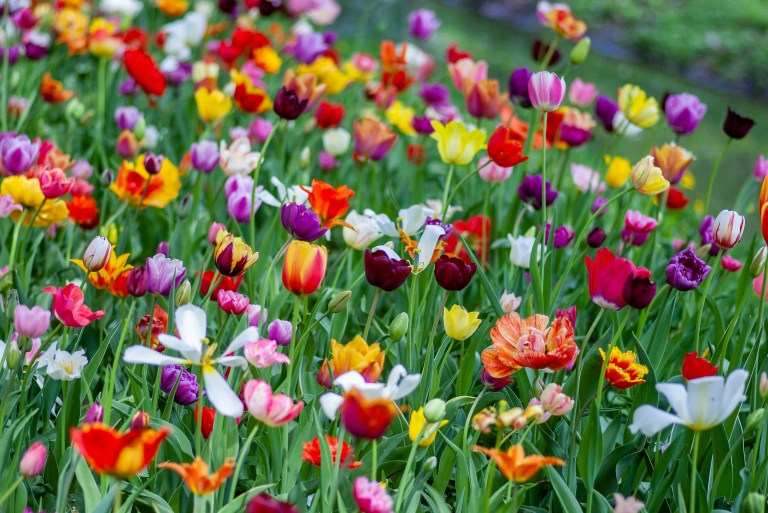David Hockney and ‘the Duty of Delight’
On the cusp of turning 80 years old in 2020, David Hockney, the British pop artist known for his vivid California landscapes, decided to go to Normandy to paint the arrival of spring on his iPad. Taking his iPad outside in ‘plein air’ (a French expression referring to the act of painting outdoors), he painted what he saw: trees, countryside landscapes, small patches of dirt and flowers, a rainy lily pad pond, still life images, a haystack glowing in the moon. One of his creations, “No. 209, 17th April 2020,” features a twisting, blooming tree that takes up the whole frame, its blossoms a customized iPad-brush of splotching whites and pinks with neon green fields in the background.

A collection of these digital paintings is now showing in an exhibit called “David Hockney: The Arrival of Spring in Normandy, 2020” at the Art Institute of Chicago in Illinois. I walked, with my mom and dad, through the long halls of giant printed paintings, glitzy springtime colors cloaking the walls with promise: magentas, emeralds and lemons. My parents were visiting me in Chicago on that sunny November day. David Hockney is one of my mom’s favorite artists. She had been looking forward to this for months and was grinning with delight the whole time. As a children’s book illustrator who also draws on an iPad, she was inspired.
My mom tells me that when she was in art school in Los Angeles in the 90s, people turned up their noses to Hockney, thinking his work wasn’t serious enough. My mom always loved him and his work — the playfulness and vividness — anyway. There is a photo of her with him when he visited her art school, Otis College of Art and Design, that I love. She, a twentysomething, bright-eyed art student, smiling next to this wrinkly-faced man with a cigarette dangling from his lips.

There are many visible mistakes in these paintings like a random black stroke in a blue sky, patches of branches he began to erase but didn’t quite extinguish completely. I love that he didn’t care enough or didn’t have the perfectionist tendency to fix and scrutinize it. He was too busy creating. Once he was done with one image, he moved onto the next, accepting what he’d made and creating again.
When I know pieces of art or books or articles were created during times of the COVID-19 or are in response to the pandemic, I hold my breath a bit; mentally preparing myself for an encounter that will be sad and difficult. Necessary, of course — and I never want to shy away from the real-life injustice and sorrows — but I still prepare and brace for that sorrow. That is why I found myself surprised and solaced at Hockney’s iPad paintings. The knowledge that the pandemic had begun that sorrowful spring made the colors of playful trees and the countryside of Normandy all the more bright.
“If you see the world as beautiful, thrilling and mysterious, as I think I do, then you feel quite alive,” Hockney once said.
This idea — the conscious effort to find delight and feel alive in the midst of suffering — reminded me of Dorothy Day. I recently read a biography of her called “Unruly Saint” by D.L. Mayfield. In it, Mayfield devotes a chapter to the “duty of delight,” one of Day’s quotes about meditating “on the good things the world has to offer as a spiritual practice, a discipline of sorts.”
For people like Day, writes Mayfield, whose lives were intimately familiar with human suffering and injustice, beauty was a sign “of the resilience of humanity in the face of cruelty. A sign of resurrection. A small redemption of all the misery the earth endured … a precious gift to be savored, to give strength to the one who needs to get up and face the realities of the world again and again.”
Beauty and delight are means of survival in a cruel world. On its website, the art institute presents Hockney’s exhibit: “In contrast to the withdrawal, isolation, and sobering events the pandemic imposed, Hockney’s paintings are a celebration of the joy of the natural world, which reminds us, as he does himself in one of his often-repeated phrases, to ‘love life.’”
To truly love life, not as a platitude but as a hard-earned love. These days, I’m holding a swirling ball of grief and uncertainty in my chest, and yet I recognize that a longing for beauty is tingling in me, too; a desire to love life because it is so precious and fleeting. A love of life, like in an old man painting spring in France on his iPad, capturing the glow of its white moon and all of the pixel-pink sunsets.
“David Hockney: The Arrival of Spring in Normandy, 2020” is on view at the Art Institute of Chicago through Jan. 9, 2023.

ABOUT THE AUTHOR

Cassidy Klein is an essayist, journalist and creative writer based in Chicago, Illinois. She grew up in Denver, Colorado, and attended Point Loma Nazarene University in San Diego, California, to study journalism and philosophy. After college Cassidy moved to Washington, D.C. for a fellowship with Sojourners Magazine, where she worked as an editorial assistant. Now in Chicago, she lives at The Fireplace, a community of artists, activists and Catholic sisters. She is a freelance writer, editor and assistant with adults with intellectual disabilities at L’Arche Chicago. Find more of her work at cassidyrklein.weebly.com.







